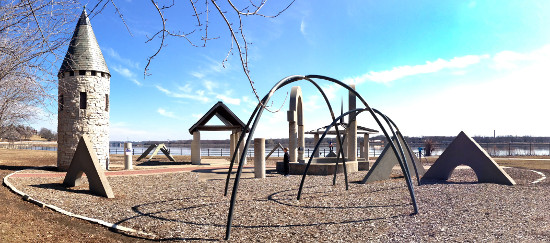
The Lindsay Architectural Sculpture Park is a grouping of structural forms derived from historic styles of buildings and homes in the Quad Cities. The park is - in turn - visually engaging, playful, and educational. It is located along the Riverfront Parkway south of the Village of East Davenport.
The park's layout feels organic. Its overall circular shape is crisscrossed with walkways that lead one past - or through - 10 primary groupings of structural forms. The largest of these structures is a 30-foot-tall limestone tower. Its slate roof is constructed in the style of the Victorian towers and turrets built in the late 1800s.
Another prominent structure is based on a Fort Armstrong blockhouse built in 1816. Made of wood, concrete, and copper, its partially completed roof shows the construction methods usually hidden under a building's exterior.
Other forms, such as the twin freestanding arches, are based on a singular architectural element rather than an entire structure. These concrete arches are meant to characterize the rounded window openings found in Romanesque Revival architecture.
These architectural forms have been streamlined, abstracted. In removing non-essential details, their underlying geometric forms have been revealed; there is a beauty in their simplicity of form. Still, the park's artful layout, the circular groupings, the variety of geometric forms, and variations in scale create a wealth of diverse patterns and compelling compositions.
Though it has an aesthetic sensibility, the park also feels playful. Predominantly made of triangles, circles, and cylinders, it looks somewhat like a village made of very large toy blocks. Intended to be interactive, it is an open invitation for stepping through openings, ducking under poles, even climbing on some of the gently sloped forms.

Educational signs are sprinkled throughout the site. For example, two photographs and a brief description are placed near a grouping of parabolic arcs made of metal poles. One is a photo of a wickiup, a seasonal home built in the late 1700s in the Sauk village at the mouth of the Rock River. The other is a photo of a Georgian-style house built a century later. The caption notes that the semicircular windows under the house's eaves echo the arches of the wickiup poles. It is a forced comparison, but it does draw attention to relationships between structures that are otherwise so very different.
The concept for an interactive and educational park grew from a series of design meetings facilitated by Quad City Arts. Nearly 50 area historic preservationists, businesspeople, recreation enthusiasts, and river activists came together over a two-year period to develop the community-built project. Lori Roderick and John Gere were its primary designers, with Roderick serving as the project's lead artist. The breadth of Gere's experience as an architect is evident in the scope of the historic architectural references. The park was dedicated and presented to the City of Davenport on May 22, 1999.
Bruce Walters is a professor of art at Western Illinois University.
This is part of an occasional series on the history of public art in the Quad Cities. If there's a piece of public art that you'd like to learn more about, e-mail the location and a brief description to BD-Walters@wiu.edu.










